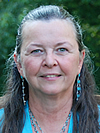 Linda C. Gundersen |
2012 Contributions to Geoinformatics Award
Presented to Linda C. Gundersen
Citation by Kerstin A. Lehnert
I am honored to present the first Geoinformatics Division award for Outstanding Contributions in Geoinformatics to Linda C. Gundersen. In a career with the U.S. Geological Survey spanning 33 years, she has made numerous scientific contributions and served for 10 years as the Chief Scientist for Geology. The first half of her career focused on research in geochemistry and environmental geology including assessing the radon potential of the United States. The second half of her career is where geoinformatics comes in, when she became a manager and could influence the way data and information were managed and made accessible.
Linda’s passion for geoinformatics began with data preservation. In 1996, as the USGS Minerals program manager, she made data preservation and integration of spatial data a priority, leading to the ability to do more integrated resource assessments and making large volumes of data publically available. In 2001 she supported the National Academy study Geoscience Data and Collections, which she promptly implemented, establishing a $1M Data Preservation Program at the USGS, partnered with the State Geological Surveys, that has brought millions of data and materials off the shelves and online.
As Chief Scientist for Geology in 2001, Linda worked with Hermann Zimmerman and Walt Snyder exploring ways USGS and NSF could partner on the emerging field of geoinformatics. She started attending and eventually co-hosting and co-organizing many USGS-NSF workshops as well as conferences and symposium at GSA and AGU devoted to geoinformatics. Her enthusiasm, support, and encouragement brought many in the geoscience community to become actively involved in geoinformatics.
I first met Linda when she served on the advisory board for EarthChem . When someone brings a good idea to Linda she tries to get it done. We told her how much we wanted USGS geochemistry in EarthChem and 6 months later the chemistry for over 400,000 USGS samples was entered into EarthChem!
Linda agreed in 2006 to help start the GSA Geoinformatics Division with Krishna Sinha and Randy Keller. To support the Division, and bolster the geoscience community’s interest and knowledge in geoinformatics, she co-hosted three Geoinformatics Conferences held in 2006, 2007, and 2008. The conferences were designed to create a community of practice and provide a forum for scientists from industry, government, and academia to share their geoinformatics research. Funds from the conferences were used to support the GSA Geoinformatics Division.
Linda has worked on numerous national geoinformatics efforts. In 2007, she started the NSF and USGS funded USGIN with Lee Allison. In 2009, She established the USGS Community for Data Integration with Kevin Gallagher. The CDI includes many hundreds of members from USGS and the informatics community, working together to develop a cyberinfrastructure for the USGS and informatics tools for everyone. In 2011, she co-supported and helped organize the GeoData 1 Workshop in Denver with NSF, Peter Fox, and others that focused on data lifecycle and informatics tools. The workshop results were used in the initial concepts for EarthCube. Most recently, Linda worked with Kevin Gallagher and Tim Kileen to make USGS a formal partner with NSF on EarthCube.
 2012 Contributions to Geoinformatics Award — Response by Linda C. Gundersen
2012 Contributions to Geoinformatics Award — Response by Linda C. Gundersen
Thank you to the Geoinformatics Division of GSA for this award. There are many scientists contributing to the success of geoinformatics who equally deserve this award and it has been my great pleasure and honor to work with them and with the ever growing geoinformatics community for the past 12 years. I am particularly indebted to David Arctur, Lee Allison, Bob Detrick, Kevin Gallagher, Art Goldstein, Peter Fox, Randy Keller, Kerstin Lehnert, Deborah McGuinness, Krishna Sinha, Walt Snyder and Herman Zimmerman for their leadership, pioneering efforts, and continuing work on behalf of geoinformatics and the building of a cyberinfrastructure for the geosciences. We have come a long way, however we still have a substantial journey ahead of us to realize the incredible potential of geoinformatics to transform the way we do science. I strongly believe that the next generation of geoscientists won’t hesitate for a second to incorporate informatics as an integral part of their day-to-day research environment. Yet today we are still struggling. In my work and in my role as a manager at the U.S. Geological Survey, I have been blessed with the ability to influence policy and program direction to incorporate geoinformatics into strategic planning, and been able to see the data management lifecycle become an accepted concept, and increasingly an accepted practice in both government and academia. We need to strongly support it becoming the standard practice for all scientists to conscientiously plan, collect, manage, and preserve the data they collect while ensuring the long term integrity and accessibility of that information through publication and placement in a public repository. We also need to continue developing the standards, concepts, tools, and semantics that allow computers and each other to understand and creatively explore our science.
I ask each of you to reach out to someone new and ask them to join this community. I also ask each of you to give some time to this Division. The GSA Geoinformatics Division could be a wonderful supporter of important emerging efforts such as EarthCube (http://earthcube.ning.com/) and become a forum for supporting advances in informatics tools and standards needed for the geosciences. We are in a powerful moment of transition to a future when we can truly have the earth at our fingertips. It is critical for us to sustain and increase our momentum, invest in geoinformatics education, incorporate it into our curriculum, urge and support students to enter the field, and work together to build a communal infrastructure that lets the power of our data shine and light the way for generations of geoscientists to come.
